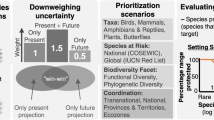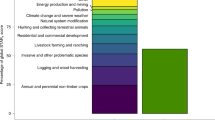Abstract
Despite widespread evidence of climate change as a threat to biodiversity, it is unclear whether government policies and agencies are adequately addressing this threat to species. Here we evaluate species sensitivity, a component of climate change vulnerability, and whether climate change is discussed as a threat in planning for climate-related management action in official documents from 1973 to 2018 for all 459 US animals listed as endangered under the Endangered Species Act. We find that 99.8% of species are sensitive to one or more of eight sensitivity factors, but agencies consider climate change as a threat to only 64% of species and plan management actions for only 18% of species. Agencies are more likely to plan actions for species sensitive to more factors, but such planning has declined since 2016. Results highlight the gap between climate change sensitivity and the attention from agencies charged with conserving endangered species.
This is a preview of subscription content, access via your institution
Access options
Access Nature and 54 other Nature Portfolio journals
Get Nature+, our best-value online-access subscription
$29.99 / 30 days
cancel any time
Subscribe to this journal
Receive 12 print issues and online access
$209.00 per year
only $17.42 per issue
Buy this article
- Purchase on Springer Link
- Instant access to full article PDF
Prices may be subject to local taxes which are calculated during checkout




Similar content being viewed by others
Data availability
Data are archived on Open Science Framework and available at https://osf.io/r9uca. A free, interactive web application containing data and results from this study is available at https://defenders-cci.org/app/ESA_climate/.
References
Lipton, D. et al. in Impacts, Risks, and Adaptation in the United States: Fourth National Climate Assessment Vol. II (eds Reidmiller, D. R. et al.) 268–321 (US Global Change Research Program, 2018).
IPCC Climate Change 2014: Synthesis Report (eds Core Writing Team, Pachauri, R. K. & Meyer, L. A.) (IPCC, 2014).
Pounds, J. et al. Widespread amphibian extinctions from epidemic disease driven by global warming. Nature 439, 161–167 (2006).
Urban, M. Accelerating extinction risk from climate change. Science 348, 571–573 (2015).
Díaz, S. et al. Summary for Policymakers of the Global Assessment Report on Biodiversity and Ecosystem Services of the Intergovernmental Science-Policy Platform on Biodiversity and Ecosystem Services (IPBES Secretariat, 2019).
Butt, N. & Gallagher, R. Using species traits to guide conservation actions under climate change. Climatic Change 151, 317–332 (2018).
Hoeppner, J. M. & Hughes, L. Climate readiness of recovery plans for threatened Australian species. Conserv. Biol. 33, 534–542 (2019).
Scott, D. & Lemieux, C. Climate change and protected area policy and planning in Canada. Forestry 81, 696–703 (2005).
Araújo, M., Alagador, D., Cabeza, M., Nogués-Bravo, D. & Thuiller, W. Climate change threatens European conservation areas. Ecol. Lett. 14, 484–492 (2011).
Evans, D. M. et al. Species recovery in the United States: increasing the effectiveness of the Endangered Species Act. Issues Ecol. 20, 1–28 (2015).
Gerber, L. R. et al. Endangered species recovery: a resource allocation problem. Science 362, 284–286 (2018).
McClanahan, T. R. et al. Conservation action in a changing climate. Conserv. Lett. 1, 53–59 (2014).
Mawdsley, J. R., O’Malley, R. & Ojima, D. S. A review of climate-change adaptation strategies for wildlife management and biodiversity conservation. Conserv. Biol. 23, 1080–1089 (2009).
Bierbaum, R. et al. A comprehensive review of climate adaptation in the United States: more than before, but less than needed. Mitig. Adapt. Strateg. Glob. Change 18, 361–406 (2013).
Wilcove, D. S., Rothstein, D., Dubow, J., Phillips, A. & Losos, E. Quantifying threats to imperiled species in the United States. Bioscience 48, 607–615 (1998).
McCright, A. & Dunlap, R. E. The politicization of climate change and polarization in the American public’s views of global warming, 2001–2010. Sociol. Q 52, 155–194 (2011).
McCright, A. M., Dunlap, R. E. & Marquart-Pyatt, S. T. Political ideology and views about climate change in the European Union. Environ. Polit. 25, 338–358 (2015).
Povilitis, A. & Suckling, K. Addressing climate change threats to endangered species in US recovery plans. Conserv. Biol. 24, 372–376 (2010).
Bernazzani, P., Bradley, B. A. & Opperman, J. J. Integrating climate change into habitat conservation plans under the US Endangered Species Act. Environ. Manag. 49, 1103–1114 (2012).
The Endangered Species Act of 1973 (US Congress, 1973).
Endangered Species Act Amendments of 1988 (US Congress, 1988).
Peters, R. & Lovejoy, T. Global Warming and Biological Diversity (Yale Univ. Press, 1992).
Ruhl, J. Climate change and the endangered species act: building bridges to the no-analog future. Environ. Law Policy Annu. Rev. 39, 10735–10745 (2009).
Pacifici, M. et al. Assessing species vulnerability to climate change. Nat. Clim. Change 5, 215–225 (2015).
Case, M. J., Lawler, J. J. & Tomasevic, J. A. Relative sensitivity to climate change of species in northwestern North America. Biol. Conserv. 187, 127–133 (2015).
Gustafson, A., Leiserowitz, A. & Maibach, E. Americans are increasingly ‘alarmed’ about global warming. Climate Note https://go.nature.com/32Kq9YQ (2019).
Trump, D. J. Presidential Executive Order on Promoting Energy Independence and Economic Growth Executive Order 13783 (The White House, 2017).
Shear, M. Trump will withdraw US from Paris Climate Agreement. The New York Times (1 June 2017).
Federal and State Endangered and Threatened Species Expenditures (US Fish and Wildlife Service, 2012).
Platt, J. How much did the US spend on the Endangered Species Act in 2012? Scientific American (1 November 2013).
Gerber, L. R. Conservation triage or injurious neglect in endangered species recovery. Proc. Natl. Acad. Sci. USA 113, 3563–3566 (2016).
Heller, N. & Zavaleta, E. Biodiversity management in the face of climate change: a review of 22 years of recommendations. Biol. Conserv. 142, 14–32 (2009).
Geyer, J. et al. Classification of climate-change-induced stresses on biological diversity. Conserv. Biol. 25, 708–715 (2011).
Schwartz, M. W. et al. Decision support frameworks and tools for conservation. Conserv. Lett. 11, e12385 (2018).
Glick, P., Stein, B. A. & Edelson, N. A. Scanning the Conservation Horizon (National Wildlife Federation, 2011).
Young, B. E., Dubois, N. S. & Rowland, E. L. Using the climate change vulnerability index to inform adaptation planning: lessons, innovations, and next steps. Wildl. Soc. Bull. 39, 174–181 (2015).
Bagne, K. E., Friggens, M. M. & Finch, D. M. A System for Assessing Vulnerability of Species (SAVS) to Climate Change (Forest Service, US Department of Agriculture, 2011).
Foden, W. B. et al. Climate change vulnerability assessment of species. WIREs Clim. Change 10, 1–36 (2018).
US Fish and Wildlife Service Information Quality Guidelines and Peer Review (US Fish and Wildlife Service, 2012).
NAO 202-735D: Scientific Integrity (NOAA, 2011).
Lankford, A. J., Svancara, L. K., Lawler, J. J. & Vierling, K. Comparison of climate change vulnerability assessments for wildlife. Wildl. Soc. Bull. 38, 386–394 (2014).
Wheatley, C. J. et al. Climate change vulnerability for species—assessing the assessments. Glob. Change Biol. 23, 3704–3715 (2017).
Delach, A. et al. Agency plans are inadequate to conserve US endangered species under climate change (data sets). Open Science Framework https://doi.org/10.17605/OSF.IO/R9UCA (2019).
Acknowledgements
We thank N. Dubois and N. Matson for valuable input and B. Dreher, M. Evans, M. Evansen, M. Lacey, S. Pastel and S. Steingard for feedback on the manuscript. Financial support for data collection was provided by University of Maryland and the Stanback Internship Program of Duke University.
Author information
Authors and Affiliations
Contributions
A.D. and A.C. designed the study. A.D., A.C., K.M.E., R.K., S.M., K.A.T. and L.J.V. collected data. A.D. and J.R.B.M. analysed data and wrote the manuscript. A.D., J.W.M., M.N.S. and J.R.B.M. interpreted results and J.W.M. built the web app. All authors provided critical feedback on the manuscript.
Corresponding author
Ethics declarations
Competing interests
The authors declare no competing interests.
Additional information
Peer review information Nature Climate Change thanks Nathalie Butt, Mark Schwartz and the other, anonymous, reviewer(s) for their contribution to the peer review of this work.
Publisher’s note Springer Nature remains neutral with regard to jurisdictional claims in published maps and institutional affiliations.
Supplementary information
Supplementary Information
Supplementary results, Figs. 1 and 2, and Tables 1 and 2.
Rights and permissions
About this article
Cite this article
Delach, A., Caldas, A., Edson, K.M. et al. Agency plans are inadequate to conserve US endangered species under climate change. Nat. Clim. Chang. 9, 999–1004 (2019). https://doi.org/10.1038/s41558-019-0620-8
Received:
Accepted:
Published:
Issue Date:
DOI: https://doi.org/10.1038/s41558-019-0620-8
This article is cited by
-
Warning sign of an accelerating decline in critically endangered killer whales (Orcinus orca)
Communications Earth & Environment (2024)
-
Low microbiome diversity in threatened amphibians from two biodiversity hotspots
Animal Microbiome (2022)



